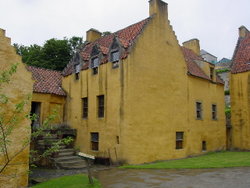
George Bruce of Carnock
Encyclopedia

Scotland
Scotland is a country that is part of the United Kingdom. Occupying the northern third of the island of Great Britain, it shares a border with England to the south and is bounded by the North Sea to the east, the Atlantic Ocean to the north and west, and the North Channel and Irish Sea to the...
merchant and engineer. He was born in Carnock
Carnock
Carnock is a village located in Fife, Scotland, approximately northwest of Dunfermline and 1 mile east of Oakley, Fife. The village is said to be named for St. Cearnock, a disciple of St. Ninian...
, near Dunfermline
Dunfermline
Dunfermline is a town and former Royal Burgh in Fife, Scotland, on high ground from the northern shore of the Firth of Forth. According to a 2008 estimate, Dunfermline has a population of 46,430, making it the second-biggest settlement in Fife. Part of the town's name comes from the Gaelic word...
.
Coal mining
Bruce was an innovator in coal miningCoal mining
The goal of coal mining is to obtain coal from the ground. Coal is valued for its energy content, and since the 1880s has been widely used to generate electricity. Steel and cement industries use coal as a fuel for extraction of iron from iron ore and for cement production. In the United States,...
techniques, introducing undersea mining into the Upper Hirst
Upper Hirst
The Upper Hirst is a coal seam in central Scotland that was mined in the 1950s through to 2002, mainly to supply Kincardine Power Station, and later, Longannet Power Station, in Fife....
seam with use of new drainage technology. These innovations attracted much interest, including a visit from King James VI
James I of England
James VI and I was King of Scots as James VI from 24 July 1567 and King of England and Ireland as James I from the union of the English and Scottish crowns on 24 March 1603...
in 1617. Sir George Bruce invited him to visit one of his mines which tunnelled down beneath the sea bed. James ventured into the tunnel which went far out into the Firth of Forth
Firth of Forth
The Firth of Forth is the estuary or firth of Scotland's River Forth, where it flows into the North Sea, between Fife to the north, and West Lothian, the City of Edinburgh and East Lothian to the south...
and found himself at a shaft point where the coal was loaded onto the ship
Ship
Since the end of the age of sail a ship has been any large buoyant marine vessel. Ships are generally distinguished from boats based on size and cargo or passenger capacity. Ships are used on lakes, seas, and rivers for a variety of activities, such as the transport of people or goods, fishing,...
s. Alarmed to find himself surrounded by water at the top of the shaft, James accused Sir George of an attempt on his life and declared that the whole affair was an act of treason
Treason
In law, treason is the crime that covers some of the more extreme acts against one's sovereign or nation. Historically, treason also covered the murder of specific social superiors, such as the murder of a husband by his wife. Treason against the king was known as high treason and treason against a...
. It was only when George Bruce pointed out the rowing boat and explained that one could either use that or return by the tunnel from whence they came that James relaxed again - and took the option of the boat journey.
Culross Palace
Between 1597 and 1611, Bruce built a mansionMansion
A mansion is a very large dwelling house. U.S. real estate brokers define a mansion as a dwelling of over . A traditional European mansion was defined as a house which contained a ballroom and tens of bedrooms...
house in Culross
Culross
The town of Culross, pronounced "Coo-ros", is a former royal burgh in Fife, Scotland.According to the 2006 estimate, the village has a population of 395...
, utilising materials from his foreign trading. This building has subsequently become known as Culross Palace
Culross Palace
Culross Palace is a late 16th - early 17th century merchant's house in Culross, Fife, Scotland.The palace, or "Great Lodging", was constructed between 1597 and 1611 by Sir George Bruce, the Laird of Carnock. Bruce was a successful merchant who had a flourishing trade with other Forth ports, the Low...
. He lavishly decorated the palace and the stunning painted ceilings
Scottish Renaissance painted ceilings
A number of Scottish houses and castles built between 1540 and 1640 have painted ceilings. This is a distinctive national style, though there is common ground with similar work elsewhere, especially in France, Spain and Scandinavia. Most surviving examples are painted simply on the boards and...
, ornate features and panelling can still be seen. Culross Palace is now under the care of the National Trust for Scotland
National Trust for Scotland
The National Trust for Scotland for Places of Historic Interest or Natural Beauty, commonly known as the National Trust for Scotland describes itself as the conservation charity that protects and promotes Scotland's natural and cultural heritage for present and future generations to...
and has been restored to its 17th century
17th century
The 17th century was the century which lasted from 1601 to 1700 in the Gregorian calendar.The 17th century falls into the Early Modern period of Europe and in that continent was characterized by the Dutch Golden Age, the Baroque cultural movement, the French Grand Siècle dominated by Louis XIV, the...
splendour. The palace building, which had faded to a white wash has been restored to its original yellow-orange exterior. The courtyard path and the garden have also been remodelled, with the garden now full of vegetables, herbs and plants, growing as they would have done in the 17th century.

